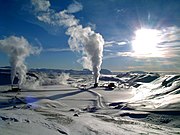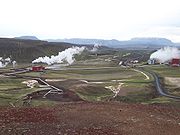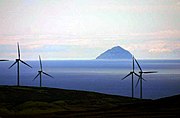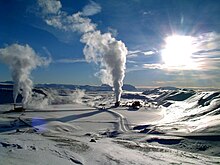Portal:Renewable energy/Selected article
historical reference. . Either the page is no longer relevant or consensus on its purpose has become unclear. To revive discussion, seek broader input via a forum such as the village pump |
| Note: Article entries here are now being transcluded directly on the main portal page. However, this page should be retained for historical reference. |
Note: When adding a new Selected article, please be sure to update the "max" value in the "Random portal component" function as well.

Construction of a hydroelectric complex can have significant environmental impact, principally in loss of arable land and population displacement. They also disrupt the natural ecology of the river involved, affecting habitats and ecosystems, and siltation and erosion patterns. While dams can ameliorate the risks of flooding, dam failure can be catastrophic.
In 2021, global installed hydropower electrical capacity reached almost 1,400 GW, the highest among all renewable energy technologies. Hydroelectricity plays a leading role in countries like Brazil, Norway and China. but there are geographical limits and environmental issues. Tidal power can be used in coastal regions. (Full article...)

Since about 1900, the Black Canyon and nearby

A protest group was formed to resist the proposed construction, and attracted support from the botanist and environmental campaigner David Bellamy. Despite the opposition, planning permission was granted in 2005 and construction began in 2007. Although work on the project was hampered by harsh weather, difficult terrain, and previous mining activity, the wind farm was officially opened on 25 September 2008 after "years of controversy", at a cost of £50 million. (Full article...)

The

Wind power became a significant energy source within South Australia over the first two decades of the 21st century. In 2015, there was an installed capacity of 1,475 MW, which accounted for 34% of electricity production in the state. This accounted for 35% of Australia's installed wind power capacity. In 2021, there was an installed capacity of 2052.95 MW, which accounted for 42.1% of the electricity production in the state in 2020.
The development of wind power capacity in South Australia has been encouraged by a number of factors. These include the Australian Government's
The load factor (or

The use of solar energy began in Israel in the 1950s with the development by Levi Yissar of a solar water heater to address the energy shortages that plagued the new country. By 1967 around 5% of water of households were solar heated and 50,000 solar heaters had been sold. With the 1970s oil crisis, Harry Zvi Tabor developed the prototype of the solar water heater now used in over 90% of Israeli homes. There are over 1.3 million solar water heaters installed as a result of mandatory solar water heating regulations.
Israeli engineers have been at the cutting edge of solar energy technology and its solar companies work on projects around the world. However, even though Israeli engineers have been involved in both photovoltaic and concentrated solar power, the earliest Israeli companies which have become market leaders in their respective fields have all been involved in concentrated solar power. Some notable examples of this are BrightSource, Solel and Brenmiller Energy which all deal with utility scale projects. Additionally, Herzliya based SolarEdge has become a market leader in inverters for non-utility scale photovoltaic solar power. (Full article...)

Geothermal power is electrical power generated from geothermal energy. Technologies in use include dry steam power stations, flash steam power stations and binary cycle power stations. Geothermal electricity generation is currently used in 26 countries, while geothermal heating is in use in 70 countries.
As of 2019, worldwide geothermal power capacity amounts to 15.4

The

In 2011, the International Energy Agency said that "the development of affordable, inexhaustible and clean solar energy technologies will have huge longer-term benefits. It will increase countries' energy security through reliance on an indigenous, inexhaustible, and mostly import-independent resource, enhance sustainability, reduce pollution, lower the costs of mitigating global warming .... these advantages are global". (Full article...)


There are several

Public policy and political leadership helps to "level the playing field" and drive the wider acceptance of renewable energy technologies. Countries such as Germany, Denmark, and Spain have led the way in implementing innovative policies which has driven most of the growth over the past decade. As of 2014, Germany has a commitment to the "Energiewende" transition to a sustainable energy economy, and Denmark has a commitment to 100% renewable energy by 2050. There are now 144 countries with renewable energy policy targets. (Full article...)

Solar water heating (SWH) is heating water by sunlight, using a solar thermal collector. A variety of configurations are available at varying cost to provide solutions in different climates and latitudes. SWHs are widely used for residential and some industrial applications.
A Sun-facing collector heats a

The production of renewable energy in Scotland is a topic that came to the fore in technical, economic, and political terms during the opening years of the 21st century. The natural resource base for renewable energy is high by European, and even global standards, with the most important potential sources being wind, wave, and tide. Renewables generate almost all of Scotland's electricity, mostly from the country's wind power.
In 2020, Scotland had 12

The Geysers is the world's largest geothermal field, containing a complex of 18 geothermal power plants, drawing steam from more than 350 wells, located in the Mayacamas Mountains approximately 72 miles (116 km) north of San Francisco, California.
Geysers produced about 20% of California's renewable energy in 2019. (Full article...)
Article 16 Mandatory renewable energy targets are part of government legislated schemes which require electricity merchandisers to source-specific amounts of aggregate electricity sales from renewable energy sources according to a fixed time frame. The objective of these schemes is to promote renewable energy and decrease dependency on fossil fuels. If this results in an additional expenditure of electricity, the additional cost is distributed across most customers by increases in other tariffs. The cost of this measure is therefore not funded by the government budgets, except for costs of establishing and monitoring the scheme and any audit and enforcement actions. As the cost of renewable energy has become cheaper than other sources, meeting and exceeding a renewable energy target will also reduce the expenditure of electricity to consumers.
At least 67 countries have

The
The dam's body was completed in 2006; the power plant was completed and fully operational by 2012, when the last of the main water turbines in the underground plant began production. Each of the main water turbines has a capacity of 700 MW. Combining the capacity of the dam's 32 main turbines with the two smaller generators (50 MW each) that provide power to the plant itself, the total electric generating capacity of the Three Gorges Dam is 22,500 MW. The last major component of the project, the ship lift, was completed in 2015. (Full article...)

A
Tide mills are usually situated in river estuaries, away from the effects of waves but close enough to the sea to have a reasonable tidal range. Cultures that built such mills have existed since the Middle Ages, and some may date back to the Roman period. (Full article...)

Renewable energy in Russia mainly consists of hydroelectric energy. The country is the
Read More...

Grand Coulee Dam is a
Power from the dam fueled the growing industries of the Northwest United States during
Read More...

The incentive to use 100% renewable energy has been created by
Read More...
Article 22 Portal:Renewable energy/Selected article/22
Article 23 Portal:Renewable energy/Selected article/23
Article 24 Portal:Renewable energy/Selected article/24
Article 25 Portal:Renewable energy/Selected article/25

